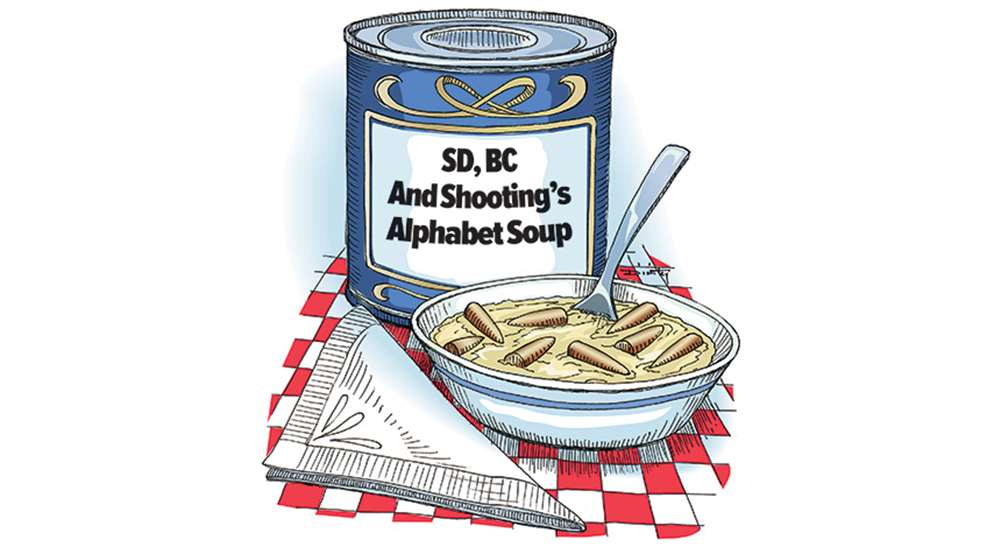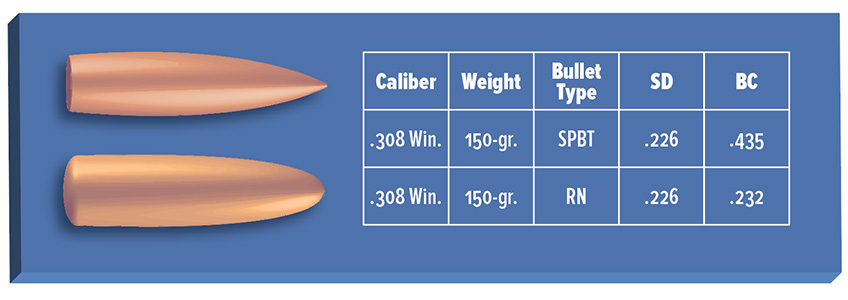
Shooting is littered with as many confusing acronyms as any other field of study, and some of them are important. Like SD and BC.
Both of these spoonfuls of alphabet soup measure characteristics and potential performance of bullets. Knowing them helps you understand in-flight performance potential (exterior ballistics) and game-killing potential (terminal ballistics.)
SD stands for sectional density. As defined by no less than the NRA Firearms Sourcebook, SD is “the ratio of bullet weight to the square of its diameter, given by the formula: SD=weight(in pounds)/(projectile diameter)2.
If mathematical formulae like this make your eyes glaze, too, consider it this way: the higher a bullet’s SD, the better its potential to maintain momentum and penetrate deeply into any medium. In any given caliber, let’s use .308, the higher SD bullet will be longer. A 150-grain spire point .308 has a SD of .226. A 180-grain comes in at SD .271, and a 220-grain boosts this to SD .331. Sectional density remains the same for all bullets in each caliber and weight class; Lead, copper, tungsten—it doesn’t matter. Reducing caliber but maintaining the weight, like a 150-grain .284 bullet, increases SD to .266. Similarly increasing caliber at the same weight decreases SD. A 150-grain .400 bullet has an SD of just .134.

Given the same nose configuration, materials and construction, this suggests more of the bullet’s mass will remain intact behind the nose of a high-SD bullet. This, of course, is like the running back having a front lineman pushing from behind to help him drive opposing players back. Bullet materials and construction play a huge role in terminal performance, so the highest SD is not guaranteed to penetrate the best. But it contributes.
BC numbers measure a bullet’s ability to resist air drag. Race cars and 18-wheeler tractor-trailers are a good analogy here. Dragsters aren’t built with high, blunt grills like an 18-wheeler. They’re built low, slim and tapered, even given rear spoilers to reduce drag.
Now think of two .308 bullets, a 150-grain spire-point boattail and a 150-grain round nose. Both carry a SD of .226, but the BC of the spire point is .435, the round nose .232. Because the round nose pushes a lot of air out of its way, it slows down, loses energy and deflects more in cross winds at all ranges. The higher-BC spire point better resists this air drag, so it flies farther, drops and drifts less, and retains more energy downrange.
Some of this can be offset by giving the low BC bullet a faster start, but drag remains the same, so most of the higher muzzle velocity is wasted. It’s just more efficient to fling higher-BC bullets.
BC is a product of bullet diameter, mass (weight) and form factor. We’ve already seen how form factor makes a difference in two 150-grain bullets. Now let’s keep roughly the same form (spire-point boattail) but increase the mass to a 180-grain .308 spire-point boat tail like the Nosler AccuBond. Its BC is .507. The BC of a 230-grain Berger Match Target is .743.
The downsides to the highest BC bullets are lower velocity (in any given cartridge like .30-06 or .300 WSM) and potential stability issues. Make a bullet too long and your barrel’s rate of rifling twist might not stabilize it. The weight doesn’t matter, the length does.
To simplify stability considerations, ammo makers generally stick with weights and forms known to stabilize in most factory rifles. This is why you don’t see 230-grain high-BC bullets offered in .30-06, but may in the new .300 PRC built with fast-twist rifling.
In conclusion, pay attention to high SD bullets to enhance penetration. Pay attention to BC to maximize in-flight efficiency.



































